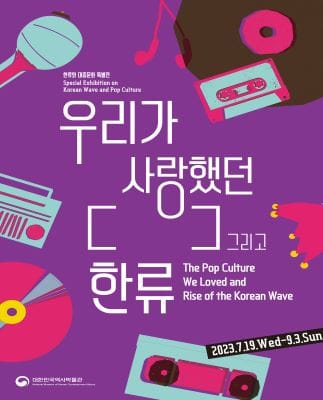The exhibition, titled “The Pop Culture We Loved, and the Rise of the Korean Wave,” debuted on Wednesday in Seoul, South Korea at the National Museum of Korean Contemporary History.
Koreans love pop culture—music, movies, TV dramas, and so on.
The number of people around the world who are enjoying Korean pop culture continues to increase. That is why it has also been called “the Korean Wave” (Hallyu). Korean singers have risen in the billboard charts, and Korean movies and TV shows have won prestigious international awards, and such news fills Korean people with pride.
The Korean Wave has enjoyed popularity worldwide, while Koreans have also accepted, enjoyed, and come to love various cultural forms from around the world. The Korean public has loved Hollywood movies since the nation’s liberation in 1945 to the present day, while fads have erupted periodically for Hong Kong movies and Japanese comic books and cartoons. Thus, ardent fans of popular culture both inside and outside have continued to produce new music, movies, and TV shows, leading ultimately to the rise of the Korean Wave. This is a result of the inclusion and affection cultivated through an openness to various cultures amid various social conditions.
What role will the Korean Wave play within the global cultural space going forward? The Korean Wave has formed amid a diverse popular culture landscape. Thus, we may expect the flowering of an even greater variety of pop-culture products throughout the world.
“Hallyu,” is known as the global boom of Korean pop culture.
The show, which is on display until September 3, tells the story of how current Korean culture has been inspired by foreign pop culture from all over the world, including American, Japanese, and Hong Kong pop culture, and has risen to global prominence.
“This is basically not an exhibition to promote Hallyu or show its history,” said Kwon Gi-jun, the exhibition’s curator, at a press conference held at the museum Thursday.
“As a Korean history museum, we hoped to offer a fresh perspective on how Hallyu was created and why it was so successful.”
According to him, the current phenomenon is the outcome of Korean society’s open acceptance of varied pop culture from around the world.
The exhibition, separated into three sections, features around 1,000 pieces illustrating the impacts of the United States, Hong Kong, and Japan on Korean pop music, films, and comic books.
Visitors will first notice two flashy stage dresses worn by Hyun Mee and Lee Geum-hee, two of the most popular Korean pop singers of the 1960s, as they enter the exhibition hall. The former passed away in April of this year at the age of 85.
Like many other Korean singers and entertainers at the time, the two began their musical careers on stage for the 8th United States Army in Korea.
The first portion dedicated to American culture also included the first LP record published in the United States in 1956 by Ok Doo-ok, the country’s first Korean singer.
There’s also an autographed LP by Kim Sisters, the first Asian female group to make their American debut.
The vinyl record “East of Make Believe,” produced under Ok’s English stage name, Moon Kim, contains two tracks: the title track and “Kanda Kanda.” The album’s discovery a decade ago changed the history of Korean music outside the country, as the Kim Sisters, a K-pop trio that debuted in the North American market in 1959, were thought to be the first Korean artist to do so.
In the 1970s and 1980s, Hong Kong films and Japanese comic books, and animated films were highly popular in Korea.
The second section of the exhibition showcases over 400 videotapes of classic Hong Kong movies of various genres, which visitors can watch using a VHS player.
They can witness stores filled with unauthorized copies of popular Japanese manga comics and J-pop songs, as well as promotional posters for Japanese animation films. They were released in Korea under Korean names since imports of Japanese pop culture were prohibited until 1998 when Korea finally abolished the embargo.
The exhibition’s third section focuses on the growth of Hallyu in the late 1990s and early 2000s. The exhibition features K-pop records, TV episodes, and movies that contributed to making hallyu a global phenomenon, as well as diverse goods purchased by K-pop lovers.
The museum shows newspapers and publications from the United States, Japan, and Taiwan showing hallyu or the popularity of Korean pop acts such as BTS, BLACKPINK, Super Junior, G-Dragon, and Psy for individuals who still don’t understand the culture’s global fame.
One section is dedicated to 42 different sorts of light sticks, from BIGBANG’s “Bang Stick” to EXO’s “LED Stick” and BTS’ “Amy Bomb.”
The majority of them, according to the museum, were borrowed from K-pop aficionados who possess them.
“An important aspect of this exhibition is the interaction between artists and their fans.”
“Korean pop culture is loved worldwide because fandom has spread globally while communicating with their stars,” Han Soo, the museum’s director, explained. According to him, the museum opted to showcase the sticks because they are regarded as a symbol of communication between Korean artists and their fans.
“We hope that many fans will take pride in being true protagonists of the Korean Wave while visiting this exhibition,” he continued.
WHAT TO TAKE AWAY FROM THIS ARTICLE:
- The album’s discovery a decade ago changed the history of Korean music outside the country, as the Kim Sisters, a K-pop trio that debuted in the North American market in 1959, were thought to be the first Korean artist to do so.
- The show, which is on display until September 3, tells the story of how current Korean culture has been inspired by foreign pop culture from all over the world, including American, Japanese, and Hong Kong pop culture, and has risen to global prominence.
- The first portion dedicated to American culture also included the first LP record published in the United States in 1956 by Ok Doo-ok, the country’s first Korean singer.























